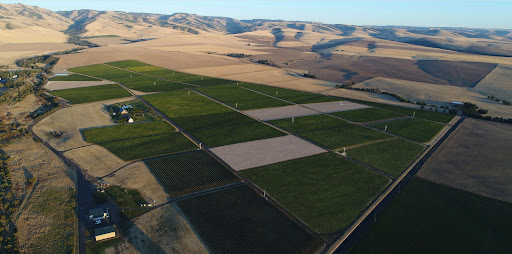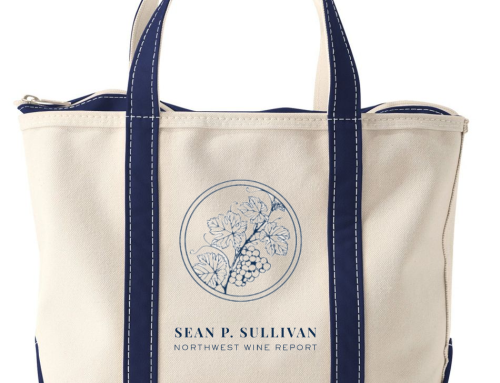Les Collines Vineyard sits like a sentinel at the base of the Blue Mountains. The Walla Walla Valley stretches out to the west. On a clear day, the views extend all the way to the Tri-Cities. If wine grapes truly do like a view, they couldn’t do much better.
“On an aesthetic level, it’s a gorgeous site,” says vineyard manager Brad Sorensen. “It seems like a very natural place to grow grapes.” Sorensen spent 14 years managing vineyards in Sonoma and Napa Valley – including sites for stalwarts Far Niente and Paul Hobbs – before taking over managing Les Collines in 2018.
French for ‘the foothills,’ Les Collines was established in 2001. At 212 planted acres, Sorensen says it is the largest contiguous vineyard in Walla Walla Valley. The entire site itself is close to 300 acres. 19 varieties are planted, with fruit going to 50+ wineries.
Les Collines’ location by the Blue Mountains gives it two distinct advantages growing wine grapes. The first is its elevation, which ranges from a high of 1,370 feet in the southeast corner down to a low of 1,140 feet in the northwest corner. This is higher than many valley vineyards.
The vineyard’s higher elevation means that, during the heat of the afternoon, Les Collines is typically two to seven degrees Fahrenheit cooler than lower elevation sites in the valley. Meanwhile Les Collines is warmer than lower elevations during the evening, as cool air flows down to lower parts of the valley. The site’s proximity to the Blue Mountains also means it takes the sun longer to reach the vineyard in the morning.
“We irrigate, some years twice just to make ourselves feel better,” says Sorensen with a laugh. “You go to other parts of the state, if you don’t start irrigating and continue throughout the entire year, you don’t have a vineyard.”
The soils at Les Collines are deep loess – windblown sand and silt that has accumulated over thousands of years. These soils retain enough moisture to keep vines healthy while allowing the rest to drain away.
“It has a really, really deep topsoil,” says Brandon Moss, partner and co-winemaker at Gramercy Cellars, which started using Les Collines Vineyard fruit in its first vintage in 2005. In fact, founder Greg Harrington credits Les Collines with inspiring him to quit his job and move to Washington to make wine.
While the entire site has loess topsoil, the lower reaches of Les Collines sit below the highest of the Missoula Floods – a series of cataclysmic events that inundated everything 1,200 feet and below in the Columbia Basin with water thousands of years ago. As a result, there are Missoula Flood gravels underneath the loess at lower locations.
Syrah is the second most planted variety at Les Collines but is the one that has received the most notoriety. The variety has produced top quality, vineyard-designated wines from Gramercy, WT Vintners, Amavi, Kerloo, and others.
“It’s always has this profound nose of violets,” Moss says of Les Collines Syrah. “It’s a very floral, pungent, violet aroma.” This is no doubt a hallmark of Les Collines. The site’s higher elevation and cooler temperatures also produce a signature.
“The greatest thing about Les Collines is when we pick, the acid numbers are just perfect, right around 6.2 to 6.5 grams per liter,” says Moss. “You just don’t have to intervene as much in what the vines are doing.”
Jean-François Pellet, director of winemaking at Amavi and Pepper Bridge (and partner at the latter), agrees that part of what makes Les Collines special is its ability to hold acidity. “Sometimes we wait a little for a little higher ripeness, but it’s not about ripeness,” Pellet says. “Sometimes it’s to get the acid down.”
While the vineyard has to date been largely known for its red wines, whites can also excel at Les Collines. Itä makes compelling examples of Semillon from the site.
“It has a dynamism to it,” Itämeri says of Les Collines. “I think it’s a really beautiful fit for the style that I’m going for.”
Les Collines’ white offerings are expanding. Sorensen recently planted Marsanne, Roussanne, Grenache Blanc, Viognier, and Picpoul (with the Picpoul planted for Gramercy).
“It’s been historically such a red place, but I think we’re particularly suited to aromatic whites,” Sorensen says.
A substantial portion of the vineyard has been deliberately left as a habitat for native animals. “It’s right next to the wild,” Sorensen says. “We have moose come down the creek and elk and mountain lions and all this great diversity.”
There is a firm focus on sustainability. Les Collines is certified Salmon Safe and is also Low Input Viticulture and Enology (LIVE) certified. Mechanical tilling is done and no herbicides are used.
“My barometer for a spray program is, I used to live in the middle of Paul Hobbs vineyard with my family, and it’s like anything I don’t feel comfortable using around my kids, I don’t use,” Sorensen says.
As more winemakers and consumers pay attention to not just how wine tastes but how it’s grown, this approach will surely become increasingly important. “They’re not just all about making high quality grapes, no matter the cost,” says Itämeri. “They, for lack of a better term, give a shit. That really matters to me. Because I also give a shit.”
Over the last 20 years, Les Collines has firmly established itself as a premier vineyard. However, with many vines now reaching 20+ years of age, the vineyard is really just stretching its legs.
“It’s a special place,” Sorensen says.
Top image courtesy of Les Collines Vineyard. Make sure to visit the vineyard’s interactive map here. All other images by Richard Duval.











Leave A Comment